Beloved Houston-based artist Forrest Prince died on July 24, 2020, after developing an infection following a fall. The work of Prince, a deeply spiritual and political self-taught artist born in 1935, is ubiquitous throughout Houston in its institutions’ collections as well as private collections.
A Houston native, Prince began making art in his 30s, in 1969. He had already led a tough life. Houston’s Station Museum of Contemporary Art, on the occasion of a solo show of his work there in 2012, writes: “Forrest Prince is an artist who lives his life and creates his art in the spirit of Jesus. His trials in overcoming drug addiction, crime, and prison as well as his new life of self-imposed poverty and his compassionate support of people in dire need, have given him the knowledge and the inner strength to make authentically spiritual works of art.”
Prince lived and worked in his compound in Houston’s North Shepherd neighborhood. In 2013, after a visit with Prince, Houston art historian and writer Pete Gershon wrote, for Robert Boyd’s publication EXU#1 (2015): “He tells anyone who asks about how God saved him in 1969 after he awoke on a bathroom floor, having overdosed on amphetamines. Two years later, while on the path to recovery, he commemorated the event by painting the words, ‘Please God, Save Me’ on a seven-foot-tall, rectangular piece of wooden siding scored to resemble brick. Like a plaintive graffito scrawled by a tortured hand in a back alley, it’s a bellwether work by one of Houston’s most uncompromising contemporary artists.”
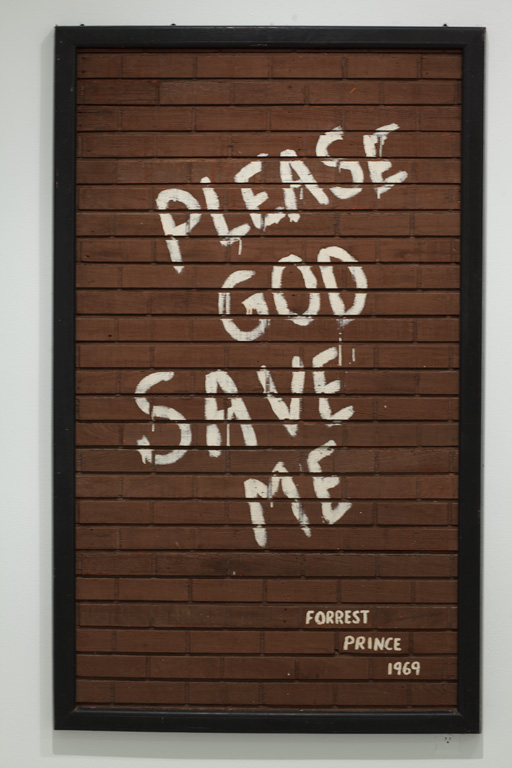
Forrest Prince, “Please God Save Me”, 1969, wood, paint, collection of Lollie Jackson. Image via the Station Museum, Houston
Prince recounted, to anyone who would listen, his childhood and early adulthood — pre-art —as tumultuous and tenuous. As he tells it, his mother was in a sanitarium and his father was an alcoholic, and Prince bounced around in foster care. By the age of 13 he was developing a taste for drugs and evading the police; in 1953 he joined the Marines Corps for a short and checkered stint in Korea and Japan. Upon his honorable discharge he returned to Houston and attempted to become a pimp, without much success. He battled depression and suicide attempts, and he slid into drug addiction and more crime. Then, as Gershon writes: “One morning he woke up on a bathroom floor in a pool of blood, with a hypodermic needle full of amphetamines stuck in the back of his leg. It was the point at which he finally did what he had vowed never to do: he turned to God for salvation.” And he started making art.
In 1976, when the Station Museum’s founder, James Harithas, was the director of Houston’s Contemporary Arts Museum, he gave Prince a solo exhibition, which, as Gershon writes, cemented “…Prince’s place in the hierarchy of Houston artists … [Harithas] placed him on equal footing with such top-tier Texans as John Alexander, James Surls, and Dick Wray.” He went on to exhibit at various other institutions in Houston, and his piece The Greatest of All is Love, a large, mirrored heart inscribed with the word ‘love,’ was acquired by the Menil Collection in 2005 thanks to a gift from Houston-based collector Bill Hill.
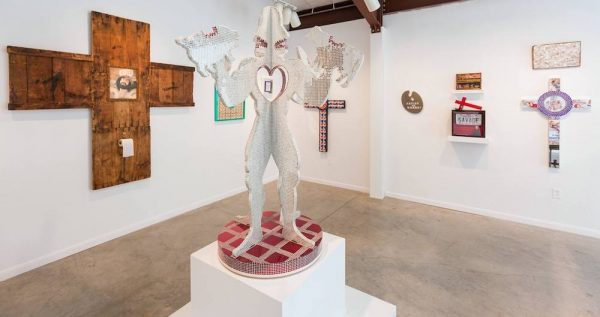
Installation view of Prince’s solo exhibition ‘The Greatest of All is Love,’ at Art League Houston, 2015
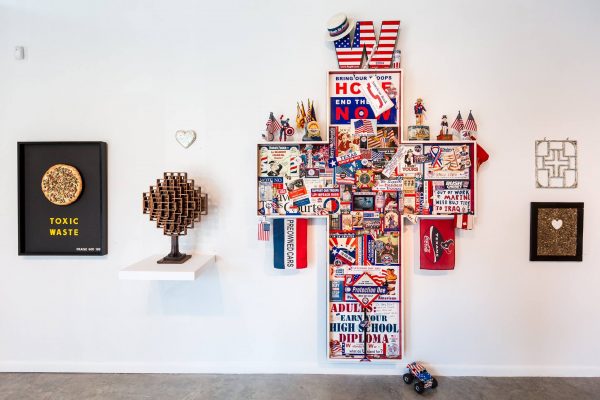
Installation view of Prince’s solo exhibition ‘The Greatest of All is Love,’ at Art League Houston, 2015
Prince was the recipient of of Art League Houston’s 2015 Lifetime Achievement Award in the Visual Arts. In an essay that accompanied the award, art historian and curator Susie Kalil stresses Prince’s lack of interest in the money, glamor, and trappings of the art world. Kalil writes: “…Forrest Prince’s work conveys an anti-commodity bias that harkens to a by-gone era when artists regarded themselves more as priests than as professionals. Like his conceptual predecessors who dematerialized objects and sometimes scattered them to the wind, Prince challenges the static, formal object.” She continues: “He uses a video cam to capture the moments and reactions of viewers; the chatter of written and spoken language to evoke time and mystical truths; base materials to vivify the space by allusions to issues and events outside the confines of the gallery.”

Forrest Prince, “You’re Eating Yourself to Death, and You’re Too Dumb to Know It”, 1990, table, chair, mixed media, collection of Carolyn Farb. Image via the Station Museum, Houston
In his art, Prince never pulled any punches; he wanted his viewer to be confronted with the message — his message — about what they were seeing. Largely political, his work addressed everything from socioeconomic inequality, to the failure of institutions, to larger concepts of greed, corruption, and America’s many other shortcomings. His materials were largely found, and his works were typically assembled from disparate pieces. Particularly of note are his artworks made from mirrors — sometimes etched, often mosaicked — in which he turned his audience back onto themselves. These pieces in particular make his viewers viscerally aware of their complacency within the systems he critiqued. Though his art was never without humor, it was also biting and raw, and challenged anything that came within its crosshairs.
In an Instagram post by artist Mel Chin dated yesterday, Chin includes an excerpt he’s written for a bio for the coming publication titled Forrest Prince: If You Want to Know the Truth (by Sandra Jensen for University North Texas Press):
“I don’t believe in god but I do believe in Forrest Prince… My first reflection in a Forrest Prince work was in ‘love’, deeply embedded within a heart shape, completely encrusted with mirrored bits. Back then, my post-art-school criticality was full of high-minded opinions and I thought the shape was overused. But my judgment was fractured by the intensity of this mosaic of love and refracted into introspection by its encrustations. It was intense enough to demand a deeper look, and I mused how it could reflect the accumulated belief of an artist. I even wondered how the bits could represent my own life, pieces that needed to be mended by a force beyond myself.”
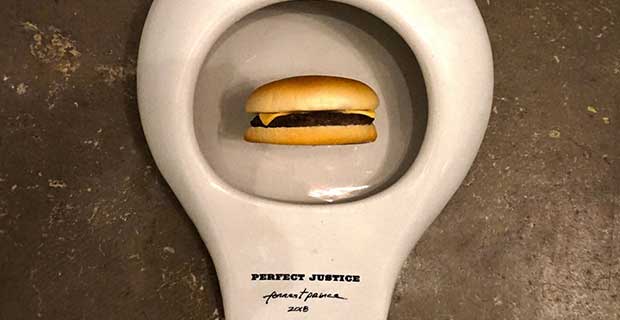
A work by Prince for his solo show ‘Awake Beloved, We’ve Slept Too Long’ at Redbud Gallery, Houston, 2018
One of the most striking things about Prince is that he practiced what he preached: he was an ardent advocate for animal rights, a strict vegetarian, and a giver of unconditional love. Though Prince would proselytize about his salvation by God if given the chance to talk about his story, he is remembered by those who knew him as an exceedingly kind and tolerant person. One of Prince’s friends remembered fondly how the artist would, on occasion, forward them emails (which often contained “a wonderful abundance of emojis”) urging them to become vegan. Prince, no matter the situation, always did what he believed was right.
Gershon echoed these sentiments, writing that Prince “live[d] a quiet, hermetic life, having given most of his time and energy over the past three decades to servicing the poor, the sick, and the elderly in assisted care facilities. [It was] a life far removed from the one he led as a young man, when he roamed the streets of the East End and the nightclubs of Montrose as a pimp, a thief, and a drug addict.”
Houston’s DiverseWorks presented a survey of Prince’s work in 1991. Caroline Huber of DiverseWorks (1985-94) wrote in the introduction to the Art League Houston’s catalog of Prince’s work: “If you have the privilege of knowing Forrest and even better, the opportunity of working with him, you will be changed. It’s impossible not to be, whether you can fully enter his world of ideas and beliefs or not. You can’t help marvel as the singularity of his vision and his whole way of being; at the seamlessness between his life and art. When DiverseWorks presented the first survey of Forrest’s work in 1991, it also had a globe shaped mound of trash at the entry and a garden growing watermelon and flowers as you left the exhibition. Forrest’s concern for the welfare of the planet and every creature that inhabits it has led him to have a diet like no one else, a spiritual path like no one else and an energy like no one else. He even smells sweeter than anyone else from all those carrots and avocados he lives on.”
We will update this post with information on services or celebrations as we receive it.



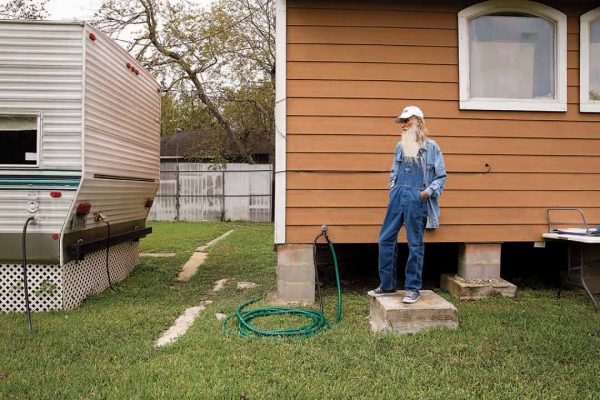

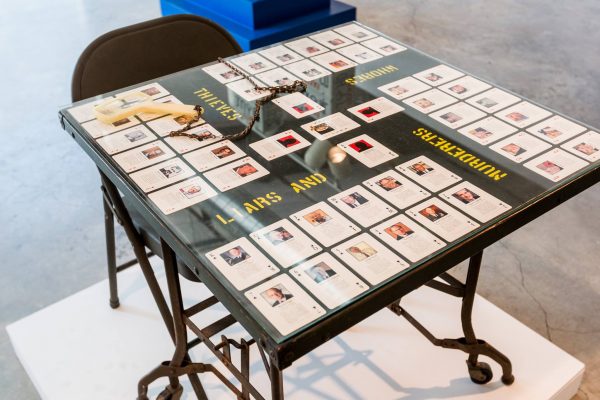
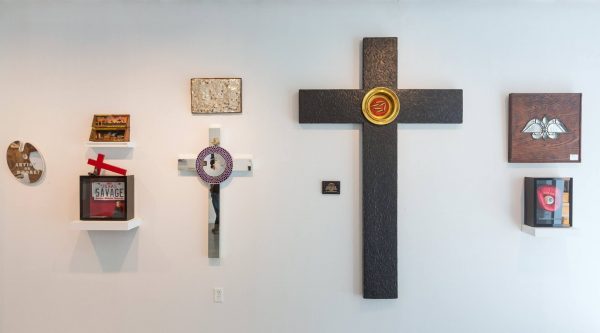
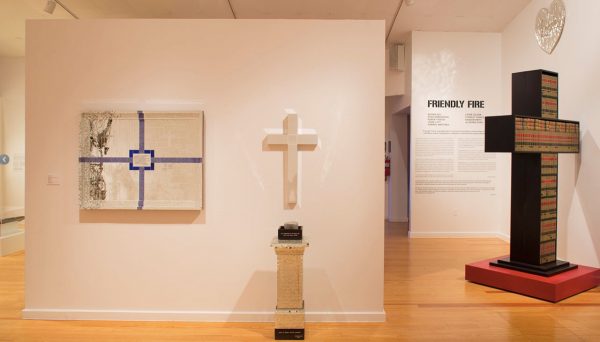

8 comments
Not knowing Forrest Prince personally now leaves me feeling empty. I know I shook his hand once at at exhibition and play that memory over in my mind, attempting to gain some channel, some connection, to his powerful images. I especially would like to dedicate a piece of my own work called “Where I AM”, an etched mirror piece influenced by Forrest Prince, currently on exhibit at Archway Gallery.
Thank you Mel Chin for your words, introspection, insight and love.
Thank you for the wonderful retrospective on the life and work of this legendary Houston heart. He was a dear friend and his spirit and fierce gentleness poured out into everything he did and everyone he met. It was a blessing to have him in our lives and our hearts are saddened by this loss. We loved him deeply.
I was honored to stand shoulder to shoulder with this truly good and unselfish man protesting animal cruelty at the Houston Rodeo and outside Neiman Marcus too.. His show was the best ever at Station Museum, if you ask me! His artwork so explicitly confronted man’s inhumanity to our animal friends, and the deeply radical message of kindness at the heart of Christ’s philosophy that many other Christians- but not Forrest!- get a little mixed up on. I have to admit I was always a little jealous/impressed that he found a way to communicate to people with his art in a way that really got across! I was just an acquaintance and did not know him well, though we texted from time to time ever since he appeared on KPFT’s Vegan World Radio as a guest a few years ago. I’m saddened because I feel like this is another light going out in the dimming constellation of Houston’s interesting and truly good people… He told me on June 27th that he had overcome a bout of Covid, but broke his leg while feeding birds. So he died from an act of kindness for the animals, the least fortunate among us of all. If I may speak for the animal rights community, I hope this expresses the deepest possible respect for our fellow Earthling, Forrest Prince. Where he falls may many more like him spring forth. ………………………. We’ll be dedicating tomorrow night’s episode of Vegan World Radio (Monday, 7pm) by rebroadcasting the 2016 interview Forrest did with the show.
I had the good fortune to know Forrest beginning in 1981. I was in undergrad school at UH Central Campus and live in a four-plex across the from him. The first day I moved into my apartment, I was approached by this little man clad only in shorts and sandals. Forrest introduced himself and said to me “Let me know if you require any assistance. ” Generally I am skeptical of people professing religion but I soon came to understand that Forrest didn’t just believe; he lived it and I admired that. He lived a strict vegetarian life and he told me that he tried to eat a baked potato and it made him sick! My mother came to visit and was amazed and amused to see Forrest making his daily trip across the street carrying a pan full of food for the neighborhood cats. He was followed by about a dozen strays, all carrying their tails erect in feline bliss. He always wore rubber gloves so he wouldn’t touch the meat. Always friendly and positive, we had many conversations during the three years that I lived there. I would run into him periodically after that and he always greeted me as a long lost friend. I just now learned of his passing and I am profoundly sorry to hear of it. We are all diminished by the loss of this gentle soul. I will never forget him and his kindness.
I believe in Texas cultural identity, Even in Houston cultural identity, not as something fix, of course, it is not an inmanence that we might get as we get for example the esence of subtance, a juice for example, have a taste diferent to another juice, we can’t enclouse cultural identity in that form as we fix taste to substance or a name to the person it belong becouse cultural identity is entailed with sensibility, with the inmaterials dimensións of things as soul, feelings, and sometimes sentimental or emotions, it is entailed with the intangibility of spirituality and exist in acervo, a memory that inhabit between self and acervo, linked with experience, however, we must find it later in visual and material culture as inscribed resonances, clues, evocation which return us later again from throught the visual to the same feeling geeting tangible expresións of the intagible, while again what the artifacts evoques in our feelings áre values, ethos (of cultural ethic and values), the sense of customs, for example or the sublime of certain sense of traditión, quotidian rituals and land, Forrest work in my sense communicates all that, his work must be seen in My opinión as ethnological from the moment it suggest a kind sincretism or sincretization which reacts to the homogeneization of the “purity” of style, or even to homogeneization in general, what is here in play in My opinión must thus be seen not as something againt the idea of purity, but a kind redemption of popular cultures valius entailed with a sense of traditión imposible to be reduced to the traditión of art, meaning the aristocracy of “pure” styles, his works unveils the formation of new cultural values in between folklóre and high culture, it so far to kitsh since is not about taste, but about cultural hibridacions, i agree at the same time with Walter imagination and perspective, we might of course speak about raushenberg in Forrest as well as on Duchamp, but i agree also with mc evilley and with Surpik and berg effort, while my reading and interpretation however is more culturalist, anthropological if You want, thanks you for the oportunity yo leave a comment, i like Forrest work a lot, abdel Hernández San juan
I had the pleasure of meeting with Mr Forrest back when he lived in his compound in Spring Branch,umm I didn’t get a chance to thank him for helping chance my life around at the time I was helping Mr Forrest with things he need help with things like maintenance, lawn care services in exchange I was given a small amount of money for my work done he truly taught me the way of a Christian at the time I was 16 I was young dumb and stupid I was selling drugs around the school after hours and at the time I was a active gang member he taught me how to better person and that I didn’t need them that I only need one person and that was God himself I remember him telling everytime I would go work for him he can tell I was down emotionally he would tell just be thank you are alive and “AS GOOD CHRISTIANS, WE KNOW TOMORROWS NOT PROMISE”
I would said today
Thank You Brother Forrest because without you telling me I need God in my life I would be either in two places right now and that is Jail or dead
Your words of wisdom will be missed I wish I would have known you passed away I would of paid my respect You will be missed
I met Forrest in 1978 , and he would come to oir Produce Comany and buy Carrots and we would talk,
i have met no one like him, and think about him often. I was proud to cll him my friend, and i miss him.
I knew him he was a great and wonderful person.